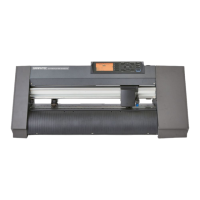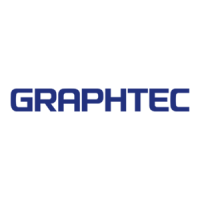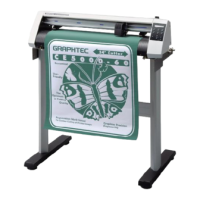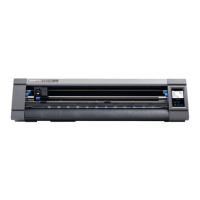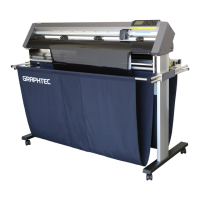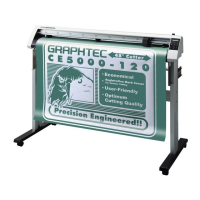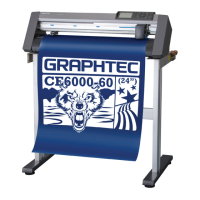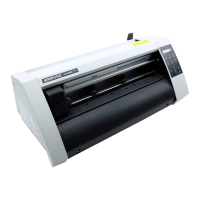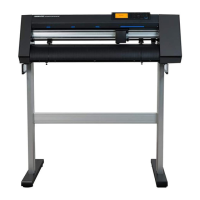
Do you have a question about the GRAPHTEC CE7000 Series and is the answer not in the manual?
| Model | CE7000 Series |
|---|---|
| Cutting Force | 30-500gf |
| Interface | USB |
| Software Compatibility | Adobe Illustrator, CorelDRAW |
| Media Types | Reflective film |
| Programmable Resolution | 0.025mm |
| Repeatability Precision | ±0.1mm |
| Command Sets | HP-GL, GP-GL |
| Power Supply | AC 100-240V, 50/60Hz |
| Operating Environment | Temperature: 5-35°C, Humidity: 35-85% RH |
| Compatible OS | Windows, Mac OS |
Lists all included accessories and their quantities for the cutting plotter.
Identifies and describes the key components and parts of the cutting plotter.
Provides step-by-step instructions for assembling the cutting plotter components.
Explains how to establish a connection between the plotter and a computer.
Details the nomenclature and preparation steps for cutter plungers.
Guides on how to load various types of media, including roll and sheet.
Explains the functions of the control panel lamps and keys for plotter operation.
Describes how to select and set tool conditions for optimal cutting.
Provides procedures for performing test cuts to ensure optimal settings.
Explains manual movement of the tool carriage and media in steps or continuously.
Details how to set the starting point for cutting operations.
Describes how to pause, resume, or stop the cutting process.
Covers setting cutting area, width, and other parameters like mirror and scale.
Explains how to duplicate cutting data stored in the buffer memory.
Describes how to use Panel Cutting to prevent media skew during long cuts.
Introduces the ARMS function for scanning registration marks using sensors.
Details how to set up and adjust the ARMS for accurate registration mark scanning.
Explains manual adjustment using 2, 3, or 4 points for axis alignment.
Provides the method for manually adjusting the position based on registration marks.
Explains tangential mode for cutting corners on thick media.
Describes setting the step pass for smoother curved line cutting.
Details how to correct deviations in cut or plotted line lengths.
Covers setting perforated or solid cut line patterns for different conditions.
Explains setting the initial blade position for media contact and area protection.
Optimizes cutting efficiency by collectively processing data to minimize movement.
Enables automatic media feeding when cut data is received to prevent shifting.
Sets the speed for tool movement when raised to affect overall cutting time.
Configures tool up movement for continuous coordinate reception.
Guides on setting up USB, LAN, and RS-232C interfaces.
Explains how to clear all output data from the plotter's buffer memory.
Details the settings for connecting the plotter via RS-232C interface.
Allows selection of display language from multiple options.
Changes coordinate values and parameters to meters or inches display.
Controls the media sensors that detect the size of the medium.
Adjusts the suction force used to affix media for stable feeding.
Configures the switching between Simple and Normal operational modes.
Adjusts the contrast of the LCD display for better readability.
Sets the command type (GP-GL, HP-GL, or AUTO) for plotter communication.
Defines the priority for tool condition settings between panel and software.
Sets the plotter's model ID response for HP-GL commands.
Specifies where dedicated data is output: USB drive or server.
Details performing data link operations using USB memory.
Explains how to print and cut using barcode data.
Enables automatic scanning of the start mark for continuous operation.
Sets tolerance for media skew during continuous operation.
Covers creating registration marks and design data for printing and cutting.
Explains how to add barcode data for linking print and cut data.
Details continuous roll media barcode cutting using data link server.
Provides guidelines for routine cleaning and care of the plotter.
Step-by-step guide on how to replace the cutter blade.
Instructions for cleaning the cutter pen to maintain performance.
Configures the alarm for blade wear based on cut distance.
Lists common symptoms, causes, and solutions for plotter problems.
Explains how to print the current plotter settings for checking.
Guides on creating self-test patterns to check plotter operation.
Describes how to perform a self-diagnostic test on sensors and switches.
Lists the technical specifications for different CE7000 models.
Details available optional items and consumable supplies for the plotter.
Provides the physical dimensions of the CE7000 models.
Illustrates the menu structure for navigating plotter settings.
Outlines the initial settings for Simple mode upon first power-up.
